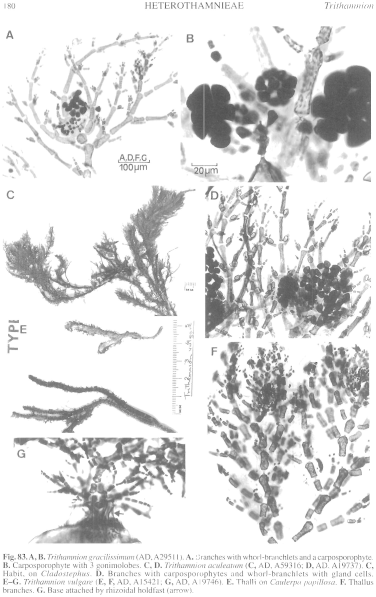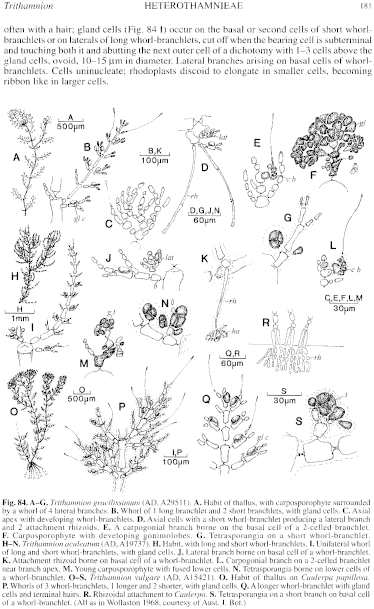|
|
|
|
|
|||||||||||
|
Electronic Flora of South Australia Species Fact Sheet
Phylum Rhodophyta – Order Ceramiales – Family Ceramiaceae – Tribe Heterothamnieae
Synonyms
Callithamnion aculeatum Harvey 1855a: 566. Lucas 1909: 49. Sonder 1881: 10.
Trithamnion tetrapinnum Wollaston 1968: 394, fig. 38A–H. Athanasiadis 1996: 101, fig. 43. Millar & Kraft 1993: 43?
Thallus (Figs 83C, 84H) with prostrate and erect axes 1–2.5 cm high, each axial cell bearing (2–) 3 (–5) whorl-branchlets, often unilaterally placed (Fig. 84I) with 1 long branchlet and 2 or 3 equal short branchlets, occasionally with other combinations; the lowest whorl on a lateral branch often consists of 4 short branchlets only. Attachment by rhizoids of elongate cells (Fig. 84K) borne on basal cells of whorl-branchlets on prostrate axes, with digitate haptera; epiphytic. Structure. Apical cells 5–7 µm in diameter and L/D 1–1.2, with chains of 6–12 small cells, enlarging to axial cells 70–160 µm in diameter and L/D 1.5–2.5 (–3), with the long whorl-branchlets upwardly curved and slightly overlapping (Fig. 84H). Long whorl-branchlets (Fig. 84I) 400–700 µm and 8–11 cells long, with opposite or slightly more abaxial branches, sometimes further branched; short whorl-branchlets (Fig. 84I) 40–100 µm and 3–6 cells long, branched one to several times; basal rachis cells usually unbranched (unless the long branchlet is developing further), 10–16 µm in diameter and L/D (1.5–) 2–3, tapering to single or paired terminal cells 4–8 µm in diameter and L/D 1–2, often with a hair; gland cells (Fig. 84I) occur on the basal or second cells of short whorl-branchlets or on laterals of long whorl-branchlets, cut off when the bearing cell is subterminal and touching both it and abutting the next outer cell of a dichotomy with 1–3 cells above the gland cells, ovoid, 10–15 µm in diameter. Lateral branches arising on basal cells of whorl-branchlets. Cells uninucleate; rhodoplasts discoid to elongate in smaller cells, becoming ribbon like in larger cells.
Reproduction: Carpogonial branches (Fig. 84L) occur on the basal cell of 2-celled whorl-branchlets near branch apices, with the terminal cell remaining as a small sterile cell on the supporting cell. Post-fertilization (Fig. 84M) 4–6 rounded gonimolobes (Fig. 83D) 90–180 µm across develop, with ovoid carposporangia 16–22 µm in diameter; 2–4 long whorl-branchlets from the lower axial cell envelop the carposporophyte. Spermatangia unknown [possible dense, much branched tufts on a mixed phase plant (with tetrasporangia) – AD, A44324].
Tetrasporangia (Fig. 84N) occur on lower cells of rachides or on branches of both long and short whorl-branchlets, ovoid, sessile, 20–30 µm in diameter, tetrahedrally to sub-decussately divided.
Type from King George Sound, W. Aust. (on Posidonia); lectotype in Herb. Harvey, TCD (Alg. Aust. Exsicc. 528).
Selected specimens: Port Noarlunga, S. Aust., on Ecklonia, 2.5 m deep (Hergstrom & Owen, 19.vii.1970; AD, A35976), and on Posidonia australis, 10 m deep (Johnson, 10.viii.1973; AD, A43983). Aldinga, S. Aust., on Laurencia forsteri, 5–6 m deep (Johnson, 7.vii.1973; AD, A44324). Seal Bay, Kangaroo I., S. Aust., on Codium galeatum, drift (Womersley, 29.x.1966; AD, A31030). Pennington Bay, Kangaroo I., S. Aust., on a lophothalioid, drift (Womersley, 22.viii. 1954; AD, A19737). (?)Port MacDonnell, S. Aust., on Chaetomorpha coliformis, drift (Womersley, 26.ix.1992; AD, A62858). Apollo Bay, Vic., on Cladostephus on pipeline, 0.5–1 m deep (Parker & Womersley, 21.viii.1988; AD, A59316).
Distribution: King George Sound, W. Aust., to Apollo Bay, Victoria. Lord Howe I. ? (Millar & Kraft 1993: 43).
Taxonomic notes: It is possible that Callithamnion spinescens Kützing (1843, p. 373), Lucas (1909, p. 49) and Sonder (1881, p. 10) from W. Aust. (Preiss) is an older name for this species, but the type (in L, 938,303...221) is a poor specimen and for the present the name is regarded as a "nomen dubium". Also C. tenellum from Rottnest I., W. Aust., may not be distinct from T. aculeatum.
References:
ATHANASIADIS, A. (1996). Morphology and classification of the Ceramioideae (Rhodophyta) based on phylogenetic principles. Opera Botanica No. 128, pp. 1–216.
HARVEY, W.H. (1855a). Some account of the marine botany of the colony of Western Australia. Trans. R. Jr. Acad. 22, 525–566.
KÜTZING, F.T. (1843). Phycologia generalis. (Leipzig.)
LUCAS, A.H.S. (1909). Revised list of the Fucoideae and Florideae of Australia. Proc. Linn. Soc. N.S.W. 34, 9–60.
MILLAR, A.J.K. & KRAFT, G.T. (1993). Catalogue of marine and freshwater Red Algae (Rhodophyta) of New South Wales, including Lord Howe Island, South-western Pacific. Aust. Syst. Bot. 6, 1–90.
SONDER, O.W. (1881). In Mueller, F., Fragmenta Phytographiae Australiae. Supplementum ad volumen undecinum: Algae Australianae hactenus cognitae, pp. 1–42, 105–107. (Melbourne.)
WOLLASTON, E.M. (1968).Morphology and taxonomy of southern Australian genera of Crouanieae Schmitz (Ceramiaceae, Rhodophyta). Aust. J. Bot. 16, 217–417.
The Marine Benthic Flora of Southern Australia Part IIIC complete list of references.
Publication:
Womersley, H.B.S. (24 December, 1998)
The Marine Benthic Flora of Southern Australia
Rhodophyta. Part IIIC. Ceramiales – Ceramiaceae, Dasyaceae
©State Herbarium of South Australia, Government of South Australia
Illustrations in Womersley Part IIIA, 1998: FIGS 83C, D, 84 H–N.

Figure 83 enlarge
Fig. 83. A, B. Trithamnion gracilissimum (AD, A29511). A. Branches with whorl-branchlets and a carposporophyte. B. Carposporophyte with 3 gonimolobes. C, D. Trithamnion aculeatum (C, AD, A59316; D, AD, A19737). C, Habit, on Cladostephus. D. Branches with carposporophytes and whorl-branchlets with gland cells. E–G. Trithamnion vulgare (E, F, AD, A15421; G, AD, A19746). E. Thalli on Caulerpa pupillosa. F. Thallus branches. G. Base attached by rhizoidal holdfast (arrow).

Figure 84 enlarge
Fig. 84. A–G. Trithamnion gracilissimum (AD, A29511). A. Habit of thallus, with carposporophyte surrounded by a whorl of 4 lateral branches. B. Whorl of 1 long branchlet and 2 short branchlets, with gland cells. C. Axial apex with developing whorl-branchlets. D. Axial cells with a short whorl-branchlet producing a lateral branch and 2 attachment rhizoids. E. A carpogonial branch borne on the basal cell of a 2-celled branchlet. F. Carposporophyte with developing gonimolobes. G. Tetrasporangia on a short whorl-branchlet. H–N. Trithamnion aculeatum (AD, A 19737). H. Habit, with long and short whorl-branchlets. I. Unilateral whorl of long and short whorl-branchlets, with gland cells. J. Lateral branch borne on basal cell of a whorl-branchlet. K. Attachment rhizoid borne on basal cell of a whorl-branchlet. L. Carpogonial branch on a 2-celled branchlet near branch apex. M. Young carposporophyte with fused lower cells. N. Tetrasporangia borne on lower cells of a whorl-branchlet. O–S. Trithamnion vulgare (AD, A15421). O. Habit of thallus on Caulerpa papillosa. P. Whorls of 3 whorl-branchlets, 1 longer and 2 shorter, with gland cells. Q. A longer whorl-branchlet with gland cells and terminal hairs. R. Rhizoidal attachment to Caulerpa. S. Tetrasporangia on a short branch on basal cell of a whorl-branchlet. (All as in Wollaston 1968, courtesy of Aust. J. Bot.)

|
Email Contact: State Herbarium of South Australia |

|